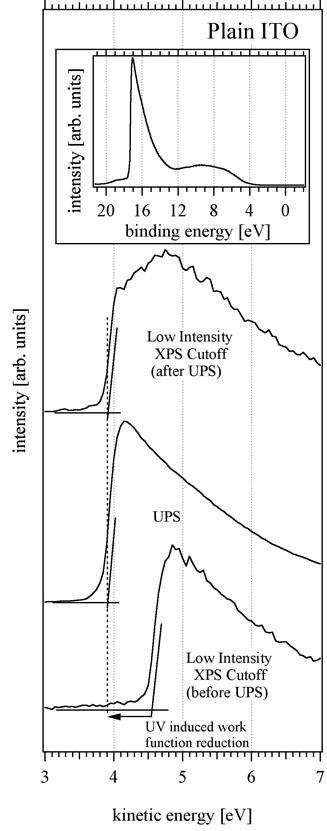Dr. Rudy Schlaf's Group_____________________________________________________
Department of Electrical Engineering - University of South Florida
Last Modified Aug 2013
(c) Rudy Schlaf
Webmaster
Work Function Measurements: The Surface Science Laboratory at the University of South Florida offers work function measurements to customers worldwide. Dr. Schlaf's group has extensive expertise in work function measurements on a multitude of materials surfaces. The Surface Science Laboratory uses the well-established photoemission spectroscopy based technique, which yields absolute work function values (in difference to Kelvin probe based techniques, which only yield a relative contact potential difference between Kelvin probe and sample surface). An area of special expertise are work function measurements on transparent conductive oxides (TCO), such as indium tin oxide (ITO). Dr. Schlaf's research shows that standard ultraviolet photoemission spectroscopy (UPS) based work function measurements on ITO (and many other oxides) are affected by a measurement artifact, which typically underestimates work function values by more than 0.5 eV. Adressing this issue, Dr. Schlaf devised a low-intensity x-ray photoemission spectroscopy (LIXPS) based technique, which allows to measure accurate values. (for more information on this unique approach, please, download (PDF): M. M. Beerbom et al.: Journal of Electron Spectroscopy and Related Phenomena 152 (1-2), pp.12-17 (2006)). Sample turn-around is usually within one week. Full characterization of surfaces with core level x-ray photoemission spectroscopy (XPS) is also available. Dr. Schlaf offers full consulting services along with measurements, i.e. Dr. Schlaf will generally be available for discussions of results and planning of experimental strategies for problem solving/product development. For more information on collaboration between the Surface Science Lab and industrial partners can be found here. Non-disclosure agreements can be arranged on short notice, if necessary. Please, contact Dr. Schlaf for discussions
or quotes at schlaf@eng.usf.edu.
|
Example (from Beerbom et al., 2006): Work function measurement on ITO glass. Bottom: The initial "low intensity x-ray photoemission spectroscopy" (LIXPS) measurement yields a secondary electron cutoff corresponding to a work function of 4.5 eV. A subsequent ultraviolet photoemission spectroscopy (UPS) measurement (second spectrum) yields a cutoff indicating an reduced work function of about 3.9 eV. This work function reduction during the UPS measurement represents a permanent photochemical (UV) modification of the surface. This is demonstrated by a subsequent LIXPS measurement (3rd spectrum), confirming the post-UPS work function value of 3.9 eV. Insert: Full UPS spectrum of ITO surface. |
